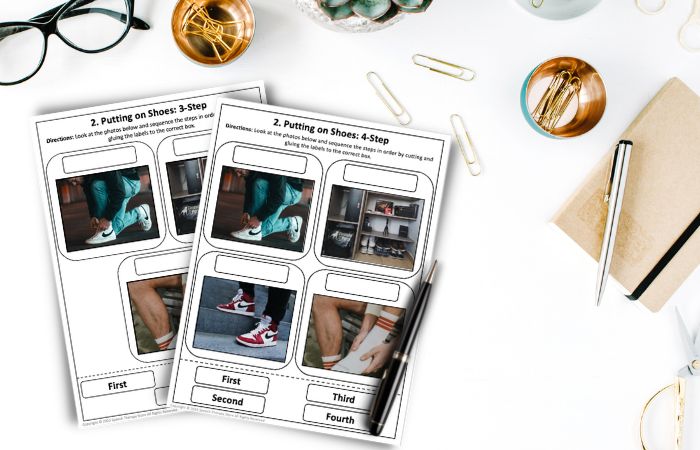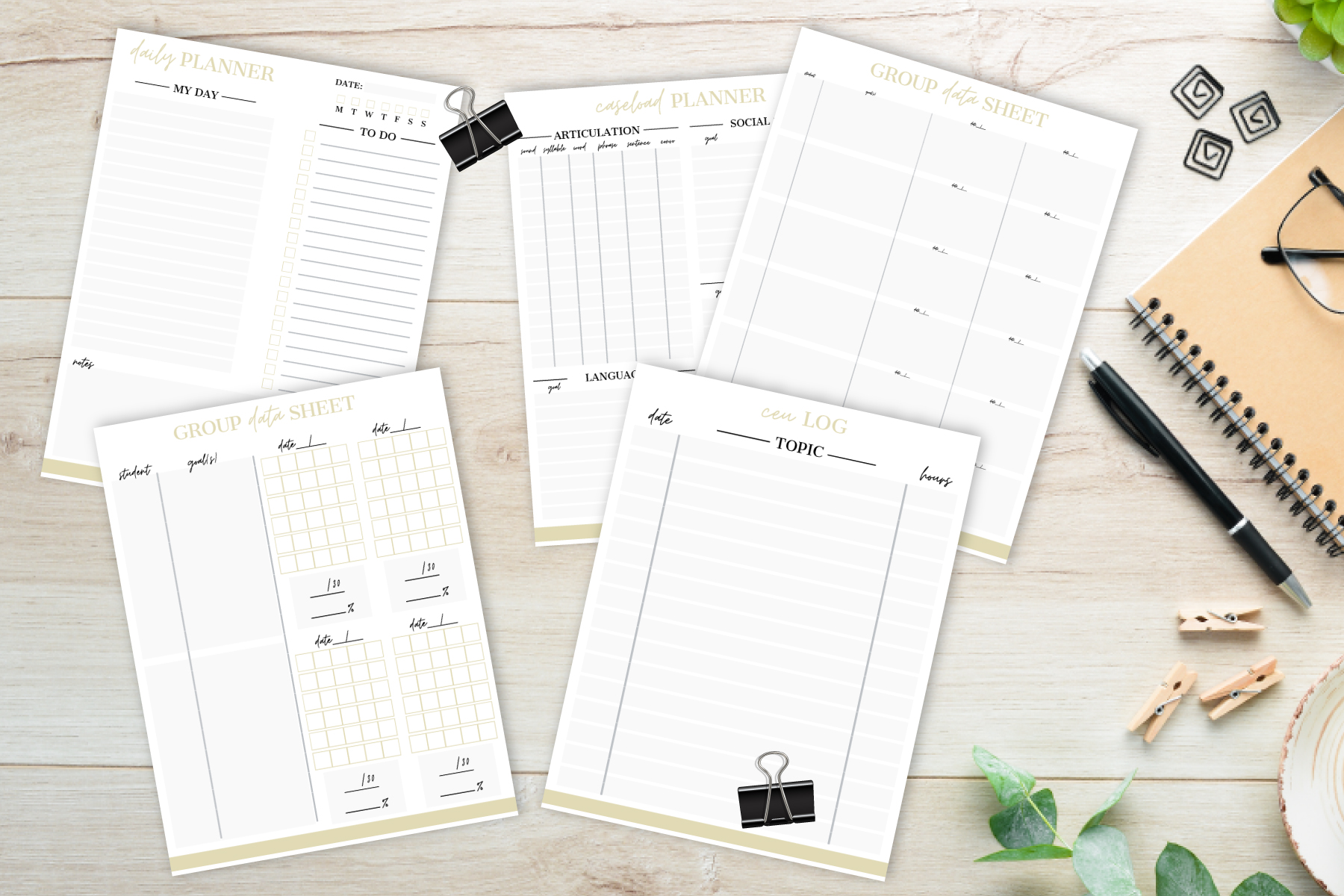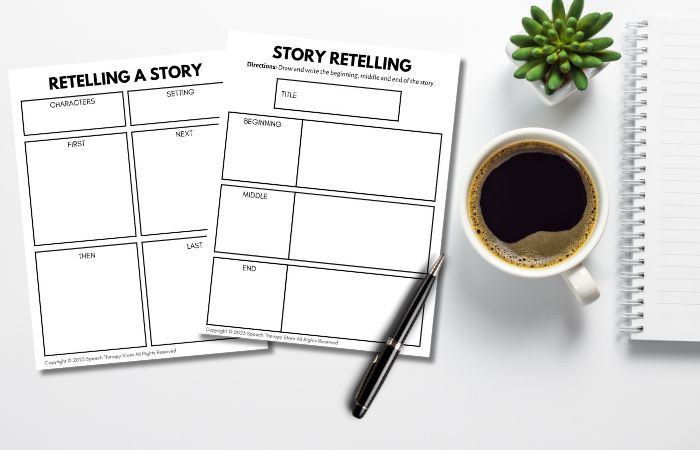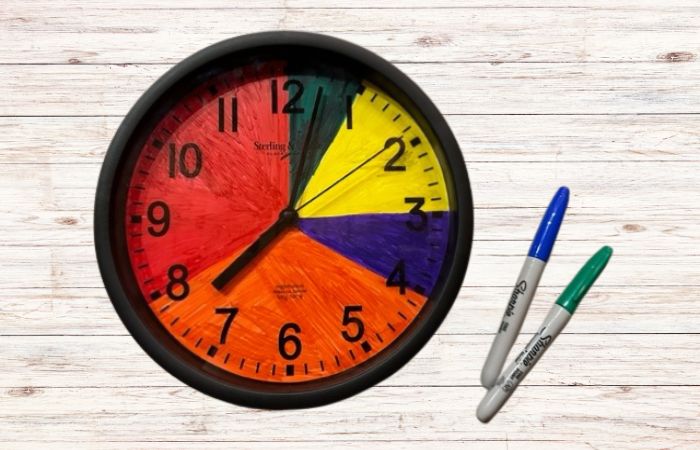If you’re looking for great IEP goals to work on sequencing goals for speech therapy, then I’ve got you covered!
Plus I’ve compiled some general sequencing info as well as a list of free resources to take the work and stress out of your therapy planning this year!
Sequencing Goals for Speech Therapy: Effective Strategies and Techniques
Sequencing goals in speech therapy are essential for helping individuals improve their communication skills and overall language development.
These goals aim to enhance a person’s ability to understand and use language sequentially, enabling them to effectively communicate their thoughts and ideas.
By targeting sequencing goals, speech therapists can help their clients generalize these skills into everyday life, making it easier for them to interact with others and engage in various social situations.
Key Takeaways
- Sequencing goals are vital in improving communication skills through the use of language in a logical and sequential manner.
- Speech therapists create individualized treatment plans that target sequencing goals while incorporating essential life skills.
- A well-rounded therapy program helps clients develop independent work and communication skills applicable to daily life situations.
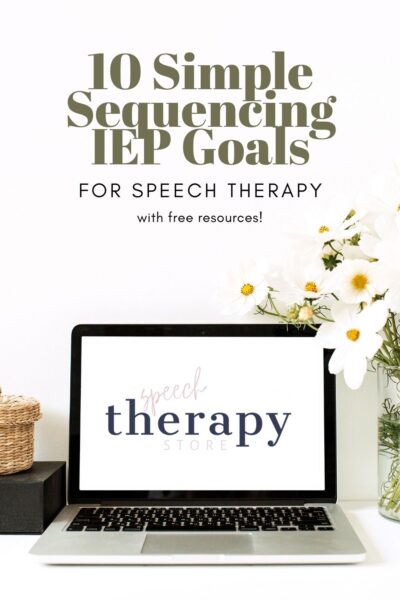
Understanding Speech Therapy Goals
An essential aspect of effective IEP goals is that they are a written goal that is clear and measurable. This allows us, as professionals, to track our students’ progress and adjust the therapy approach as needed.
When writing IEP goals, we commonly consider the following components:
- Specific skill targeted: The goal should clearly state the particular area in which the student is expected to improve with a what the student will do statement.
- Measurable criteria: The goal should include a quantifiable aspect, such as a percentage or frequency, to help track progress.
- Attainable – The goal is achievable and is realistic for your student or client to reach. Along with any support the student may need to achieve the goal.
- Relevant to a student’s individual needs: The goal should focus on skills that are meaningful to the student’s growth and development in communication.
- Time-bound: The goal should include a time frame for achieving the expected improvement.
In the context of speech therapy, sequencing goals are often critical. Sequencing is a fundamental skill necessary for understanding and organizing information and plays a crucial role in narrative development.
Effective IEP goals for targeting sequencing may include:
- Improving the student’s ability to retell stories in a logical and sequential way.
- Enhancing the student’s understanding of story structure by identifying main ideas and key details.
- Strengthening the student’s ability to sequence daily routines, such as getting dressed or brushing their teeth.
As we develop and implement speech therapy goals, it is important to remember that collaboration with other professionals, such as classroom teachers and parents, is critical for success. By working together, we can create a supportive environment that promotes the development and achievement of our student’s goals.
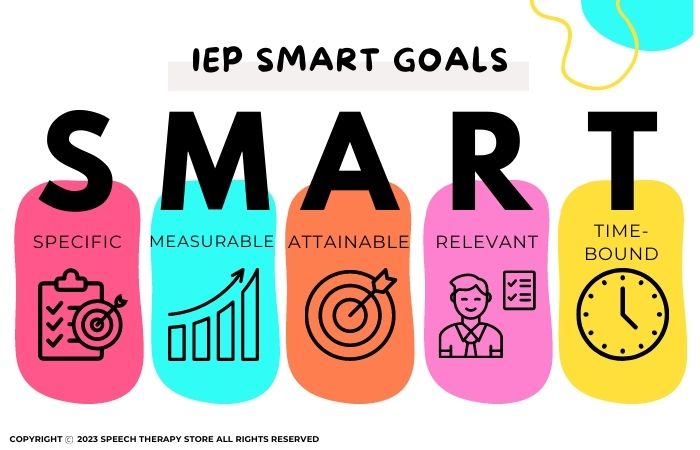
Role of Speech-Language Pathologists When Working on Sequencing Goals
One key area that we often work on is sequencing. This skill is essential for individuals to communicate effectively and understand complex information. We develop personalized therapy plans and support clients as they progress through various sequencing goals related to their specific needs.
There are several components to consider when addressing sequencing in speech therapy:
- Story structure: We help individuals understand the organization of stories and how events typically unfold.
- Main ideas: We teach clients to identify central themes and messages in different types of communication.
- Key details: We work with clients to pick out important facts and figures from a larger body of information.
In addition to these components, different sequencing activities are employed to target a client’s specific needs. Some examples include:
- Real-life scenarios: We design exercises based on daily tasks, such as making a sandwich, tying shoelaces, or brushing teeth.
- Puzzles and games: We use enjoyable activities to engage clients and motivate them to improve their sequencing skills.
- Visual aids: We incorporate visual tools like cards and charts to visually demonstrate the correct order of steps in a process.
10 Sequencing Speech Goals
When it comes to optimizing goal writing for sequencing goals in speech therapy, we need to focus on creating specific, measurable, attainable, relevant, and time-bound (SMART) objectives.
Effective goal writing should facilitate individualized and targeted therapy sessions that directly address each patient’s unique needs.
Sequencing Words and Phrases
- By [date], given a set of three unrelated words or phrases, STUDENT will verbally sequence them into a coherent and grammatically correct sentence with 80% accuracy in 4 out of 5 opportunities.
Sequencing Story Events
- By [date], when presented with a short story or passage, STUDENT will verbally identify and sequence the main events in the correct order with 80% accuracy in 4 out of 5 opportunities.
- By [date], given a story or activity, STUDENT will sequence the story or activity that includes # parts with 80% accuracy in 4 out of 5 opportunities.
Sequencing Multi-Step Directions
- By [date], STUDENT will follow multi-step verbal directions in the correct sequence, containing up to three steps, with 80% accuracy in 4 out of 5 opportunities.
Sequencing Conversational Turn-Taking
- By [date], during a structured conversation, STUDENT will take turns speaking in a sequence, waiting for a pause in the conversation before contributing, with 80% accuracy in 4 out of 5 opportunities.
Sequencing Phonological Patterns
- By [date], when presented with a series of phonemes or syllables, STUDENT will verbally sequence them to form a target word, demonstrating correct articulation and phonological patterns, with 80% accuracy in 4 out of 5 opportunities.
Sequencing Narrative Elements
- By [date], STUDENT will create and verbally express a cohesive narrative that includes a clear beginning, middle, and end, with logical sequencing of events, achieving 80% accuracy in 4 out of 5 opportunities.
- By [date], given visual cues (e.g., sequencing cards) and a story, STUDENT will sequence the story including problem and solution with 80% accuracy in 4 out of 5 opportunities.
- By [date], given a story or activity, STUDENT will use sequence words to verbally order a story or activity (e.g., first, next, then, after, last) with 80% accuracy in 4 out of 5 opportunities.
Sequencing Temporal Concepts
- By [date], STUDENT will accurately use temporal concepts (e.g., first, next, then, finally) to verbally describe the order of events in a given task or activity, achieving 80% accuracy in 4 out of 5 opportunities.

See Also: 432+ Free Measurable IEP Goals and Objective Bank
Different Supports to Use When Sequencing
- Visual Prompts – include non verbal cues that can assist children in understanding and performing target actions or behaviors.
They include visual aids such as picture cards, drawings, or real objects.
Visual prompts are a great way to help children better grasp the concept of sequencing goals because of the visual cue in hand.
- Verbal prompts – are when we use spoken language to guide the child in performing a specific action or behavior.
A verbal cue or prompt can range from simple one-word instructions to more complex sentences.
Verbal prompts aid in the child’s comprehension of the target behavior and help reinforce the sequencing goals.
When implementing verbal prompts in therapy, it’s important to consider the following:
- Keep instructions clear and concise
- Adjust your language based on the child’s developmental level
- Gradually fade the prompts as the child becomes more independent
- Utilizing Graphic Organizers – These visual tools help our clients understand and organize information within a narrative, while also improving their ability to express and sequence their thoughts coherently.
- Story Map – breaks down narratives into components such as characters, settings, problems, and solutions. When we scaffold this process, we provide our clients with a structure for their retelling approach. This enhances their vocabulary skills and syntax when communicating.
- Sequence Chart – a linear representation of events in a story, requiring the student to arrange events in a logical order.
In our practice, we’ve observed that the use of graphic organizers not only benefits our clients in achieving their sequencing goals but also contributes to improved reading comprehension and overall communication skills.
As confident and knowledgeable speech therapists, we can leverage these visual aids to help our clients accurately identify, sequence, and express the essential elements of a narrative, fostering their success in reaching their speech therapy goals.
Measuring Progress Towards Sequencing Goals
Data Collections
To know if your student is making progress it is essential that you as the therapist are measuring your student’s progress through data collection.
It is by consistently tracking your child or student’s progress that you can make informed decisions about therapy and more effectively communicate with other professionals or parents.
To ensure that you have the right measurable goals, focus on creating goals that are objectively measurable and specific to the individual’s needs. (see goals above)
Google Forms
Using Google Forms is another tool that provides a systematic way to track and monitor an individual’s progress toward their articulation goals.
By using Google Forms, you can record speech data, set measurable goals, and track progress in a single, organized system.
Additionally, using a Google Form allows for you to easily collaborate with other professionals and helps you evaluate the effectiveness of the therapy provided.
Google Forms How to Video
Watch this short video showing you exactly how to implement using Google Forms for your data collection.
See Also: Narrative Goals for Speech Therapy
Lesson Plans and Therapy Ideas for Working on Sequencing Skills
When working on sequencing skills here are some of the best ways you can focus on structured language activities to work on your student’s sequencing skills:
- Sequence Words and Phrases (sentence structure)
- Sequence Simple Story Events
- Following Multi-Step Directions
- Conversational Turn-Taking
- Sequencing Narrative Elements
- logical sequencing of events
- using visual cues (sequencing cards) to sequence the story along with the story problem and solution
- use sequencing words (first, next, then, last)
- Sequencing Temporal Concepts
- daily life skill routines
- developing independent work skills
Sequencing Words and Phrases
Incorporating simple stories into speech therapy sessions helps clients practice their sequencing skills, which is essential for constructing a coherent, grammatically correct complex sentence.
We can start with a basic three-part structure: beginning, middle, and end.
For instance, you could give your students 3 words or 3 phrases that they can then put into a complete sentence.
- Given the following 3 words (boy, jumped, the) would become: “The boy jumped”.
- Given the following 3 phrases (the big lake, the boy, jumped across) would become: “The boy jumped across the big lake”.
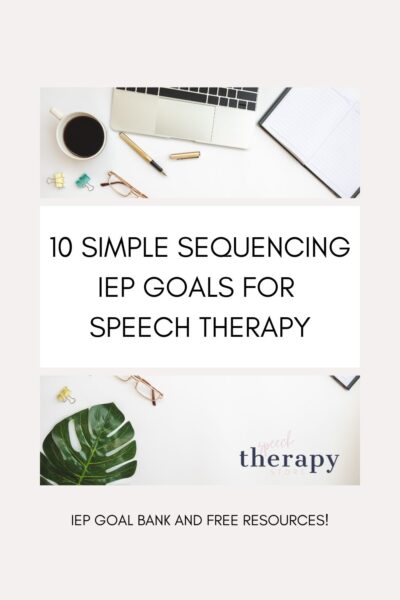
Sequencing Story Events
Incorporating short stories into speech therapy can be an effective way to address narrative goals and improve story-retelling skills. By using shorter narratives, we can focus on specific language and sequencing skills while keeping our clients engaged.
- Wordless Book – One approach to achieving narrative goals with short stories is to use wordless books or a picture scene. These books solely rely on visual storytelling and challenge clients to create their own version of the story. This method encourages clients to pay close attention to characters, settings, and actions while fostering creativity in storytelling.
Additionally, this strategy helps clients develop a deeper understanding of story grammar, as they must rely solely on the images to identify the characters, setting, problem, and resolution.
For Example: Good Dog, Carl
Good Dog, Carl by Alexander Day is perfect if you’re looking for wordless books. Using wordless picture books can be a great first step when introducing using books in therapy. The author has many more favorite wordless picture books. This story follows a dog named Carl who has to babysit while his Mom is away and even though the baby and Carl make a mess Carl is a good dog and makes sure to clear up before his mom comes home.
- Sequencing – After reading the story, have students practice sequencing by ordering the events from first, next, then, and last to show they understand the order of events.
Digital Version:
(This digital version is 9 min and has a 4-5 min blurb before about how this is a book with very few words, but we can use the pictures to predict, make inferences etc).
- Wordless Videos – Are also another fun way to work on sequencing story elements. Using our wordless video sequencing cards you can cut out each picture card and then put them into the correct order.
- Using Short Stories – We can present clients with various short stories in a logical, sequential order. By doing so, clients practice retelling the story while implementing appropriate vocabulary and syntax. These stories should be suitably short, allowing clients to easily grasp the main event sequence and eventually generalize their skills to more complex narratives.
Following Multi-Step Directions
Practicing following multi-step directions is another fun way to practice sequencing skills.
Here is a list of my multi-step resources:
- Winter Crafts
- February Card Making
- Seasonal Following Directions
Conversational Turn-Taking
When working on sequencing skills, during turn-taking you can use wh questions to help get the conversation going. Here are 4 ideas to keep a conversation going for middle school and high school aged students by asking follow-up questions.
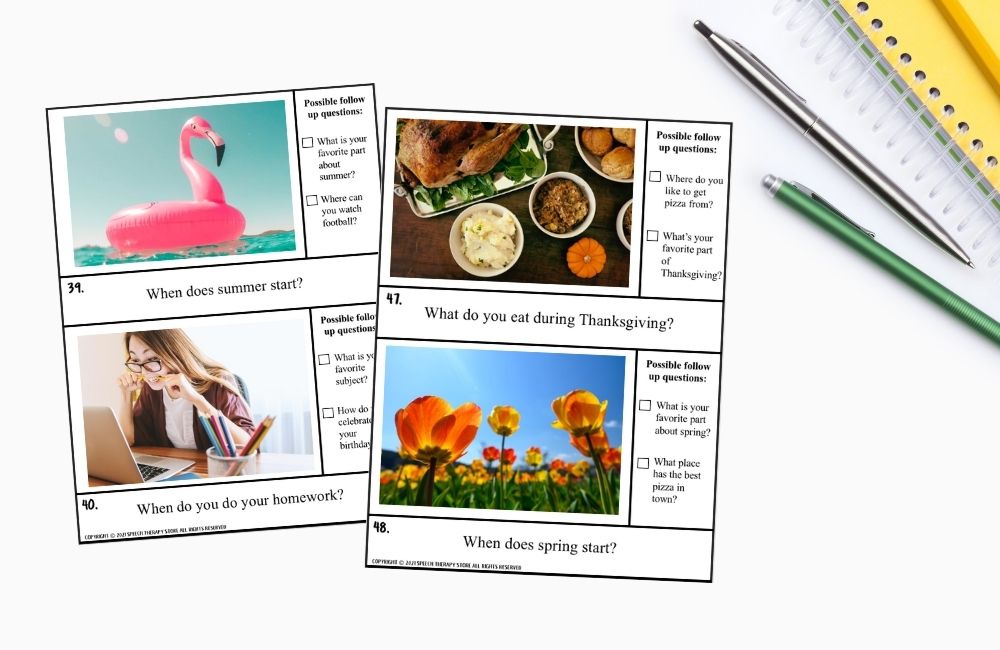
Sequencing Narrative Elements
When working on sequencing skills, it’s necessary to break down the process into smaller steps. Here’s a helpful method to follow:
- Introduce the reading passage: Provide a brief overview of the story and introduce key elements such as characters and settings.
- Read the story: Read the story aloud, and if possible, provide visuals to engage clients further.
- Discuss the story: Encourage clients to share their thoughts on the story, focusing on characters, setting, problem, and resolution.
- Practice retelling the story: Have clients try to retell the story in their own words while focusing on the correct sequence of events.
Here are the skills you can practice:
- logical sequencing of events
- using visual cues (sequencing cards) to sequence the story along with the story problem and solution
- use sequencing words (first, next, then, last)
Sequencing Temporal Concepts
- Daily life skill routines: Break down everyday tasks into manageable steps, giving our students the chance to practice independently.
While guiding our students through these activities, we must gradually fade our support to foster their independence. By practicing these skills across various contexts, they are more likely to develop and master independent life skills.
- Developing Independent Work Skills: One critical aspect of independent work is providing our students with clear and achievable expectations. To do this, we can utilize visual schedules and checklists, supporting them in understanding the order of tasks and monitoring their progress.
It’s also essential to offer structured practice opportunities. By creating activities with a clear beginning, middle, and end, our students can develop a better understanding of sequences within their daily lives.
For example, we could use:
- Task boxes: Organize step-by-step activities with visual and tangible materials within a box.
- Following a Work Schedule: Learning to follow a work schedule. You can start by creating a work schedule to follow.
- Advocating in the Community: Practice advocating in the community following these 5 steps.

See Also: 31 Best Wordless Videos To Teach Problem Solving
Conclusion: Seqencing Goals for Speech Therapy
By targeting sequencing goals, speech therapists can help their clients generalize these skills into everyday life, making it easier for them to interact with others and engage in various social situations.
We hope our resources, as well as this goal bank, helps you implement sequential practice into your therapy sessions!
If you enjoyed this post you won’t want to miss my 43+ Sequencing Activities Speech Therapy {Free Resources!}.
Frequently Asked Questions – Sequencing Goals for Speech Therapy
What are common sequencing goals in speech therapy?
Sequencing goals in speech therapy are essential for helping individuals improve their narrative abilities and understanding of time-based events. Common sequencing goals include identifying key details, retelling stories in a logical and sequential way, and organizing thoughts chronologically.
How can sequencing goals improve communication skills?
Working on sequencing goals in speech therapy can lead to improved communication skills by helping individuals organize and express their thoughts in a coherent manner. As they practice sequencing skills, they’ll also enhance their understanding of time and event connections, ultimately improving their conversational and storytelling abilities.
What are effective sequencing activities in speech therapy?
Effective sequencing activities in speech therapy can range from using sequencing pictures to guide story retelling, to engaging in functional sequencing tasks, such as Safe Sitting to Standing Transfers. Other activities might involve creating visual timelines, using cue cards, or role-playing stories and conversations.
How do IEP goals relate to sequencing in speech therapy?
Individualized Education Program (IEP) goals are important for guiding the progress of students receiving speech therapy. When setting IEP goals for sequencing, speech therapists and educators consider a student’s unique needs, ensuring they align with overall communication skill targets. IEP goals for speech therapy can encompass various aspects related to sequencing, such as expressive language, receptive language, and pragmatics.
What are examples of story retell goals in speech therapy?
Story retell goals in speech therapy focus on enabling individuals to accurately and coherently retell stories they hear or read. Some examples include recalling the main idea, identifying key details, sequencing events in order, describing characters, and making connections to personal experiences.
How can expressive language goals support sequencing skills?
Expressive language goals in speech therapy focus on helping individuals articulate their thoughts, emotions, and ideas effectively. By working on expressive language, individuals can improve their ability to convey information and stories in a sequential and logical manner. This practice will reinforce their sequencing skills and ultimately enhance their overall communication abilities.
Want Even More Lesson Plans for Speech Therapy?
- Free SLP Planner [Updated Yearly]
- 917+ Best Free Boom Cards for Speech Therapy
- 31 Best Wordless Videos to Teach Problem Solving
- 133+ Categories List for Speech Therapy
- The Best Handout for Phonological Processing Disorder Therapy
Want the Best of the Bests?
Be sure to check out our most popular posts below!
- 21 Best Reinforcement Games for Speech Therapy / Teletherapy
- Best IEP Resources
- 71+ Free Social Problem-Solving Scenarios
- 430+ Free Multisyllabic Words List Activity Bundle
- 432+ Free Measurable IEP Goals and Objectives Bank
- 279+ Free Speech Therapy Digital Materials
- 179+ Free Speech Therapy Wh-Questions Printable

